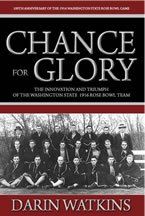Article first published as Book Review: 'Chance for Glory' by Darin Watkins on Blogcritics.
November 2, 2015
Chance for Glory:
The Innovation and Triumph
of the Washington State 1916 Rose Bowl Team
Darin Watkins
Aviva Publishing (2015)
ISBN: 978-1-943164-40-0
New Book Reveals Untold Story of First Rose Bowl at 100-Year Anniversary
 Chance for Glory is the kind of book from which great sports movies are made. It has everything in it that a true sports fan or just the lover of a good story desires, from a compelling plot to interesting characters, a blend of history, a lot of action, and a fair dose of humor. And it’s being released just in time to celebrate the one-hundred-year anniversary of the first Rose Bowl game played by Washington State College against Brown University in 1916.
Chance for Glory is the kind of book from which great sports movies are made. It has everything in it that a true sports fan or just the lover of a good story desires, from a compelling plot to interesting characters, a blend of history, a lot of action, and a fair dose of humor. And it’s being released just in time to celebrate the one-hundred-year anniversary of the first Rose Bowl game played by Washington State College against Brown University in 1916.
Since author Darin Watkins is an alumnus of what is now Washington State University, his focus, of course, is on the Washington team, and he begins the story by depicting for us a young school struggling to survive against its larger rival, the University of Washington, which wanted to limit what its sister school could teach.
The opening chapter depicts a fascinating early football game from 1912 played at West Point—a game that would have among its players the Olympic athlete Jim Thorpe and future general and U.S. President, Dwight D. Eisenhower. One of the coaches at that game was “Pop” Warner, the man who was coach to William Dietz and recommended him as coach to Washington State College when it badly needed a good coach.
Washington State had a long history of losing its football games, but Coach Dietz quickly turned that around. I’ll let readers explore his methods for themselves, but I will say he was very innovative. All the more remarkable was that he was Native American at a time when racism was predominant. In 1915, when he became coach of the Washington State Cougars, it was only twenty-five years since the massacre at Wounded Knee. But it wasn’t long before Dietz won over his players’ trust and he had them believing they could succeed not only as a team but as a powerful rival to other teams throughout the Pacific Northwest.
The events that follow are like a running film montage of one successive win after another, and yet, Watkins takes the time to describe each game and each major play, and he brings these historical people to life, investing feelings and emotions into them, making this book read like good historical fiction, yet be full of facts. Each of the players becomes an individual to us, and we get to know them both on and off the football field, including, in some cases, which ladies they dated. The amount of research Watkins did to pull together all these pieces and get insight into his characters is amazing, and he documents it all, yet the book reads smoothly like a novel more than a history.
As the Cougars stack up win after win, they begin to gain national attention, and before long, they are invited to participate in the first Rose Bowl Tournament. Of course, the Rose Bowl is a big deal today, but in 1915, no one was sure it would even succeed. Watkins depicts the struggles of the committee to get attention and sell tickets, the first Tournament of Roses parade, the publicity, and the overall results that transformed the tournament into an American institution.
One fascinating aspect of the Rose Bowl was that the Cougars, since they were going to Pasadena anyway, were invited to be in a Hollywood film—Tom Brown Goes to Harvard—part of a popular silent film series of the day, which included a football game. Watkins’ presentation of this glimpse at early movie-making is fascinating and humorous.
And then it’s on to the Rose Bowl. Watkins fills us in on every play, every cheer, every worry, and eventually, the great triumph. Through the written word, Watkins provides a very visual story of an event that would make history.
Few American stories of overcoming adversity are as thrilling and enjoyable to read as Chance for Glory. Watkins’ ability to bring history alive places this book beside other great history storytelling examples like Erik Larson’s Devil in the White City about the Chicago World’s Fair of 1893, and its triumphant message is worthy of a feel-good Disney film.
How wonderful that Watkins has timed this book to appear at the hundredth anniversary of the Rose Bowl. The Washington State Cougars’ efforts give new life and meaning to the game of football by reminding us that anyone with some courage and a dream can succeed, whether at sports or anything else.
For more information about Darin Watkins and Chance for Glory, visit www.Chance4Glory.com and when you do, make sure you don’t miss the actual video clip from the 1916 Rose Bowl game.
— Tyler R. Tichelaar, Ph.D., and award-winning author of Narrow Lives and The Best Place

